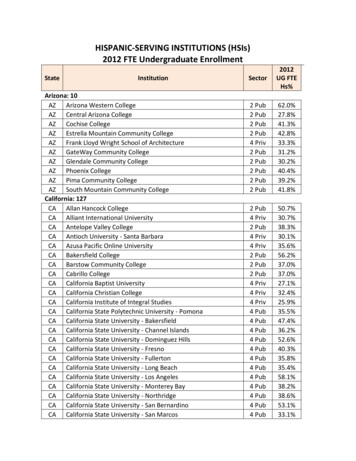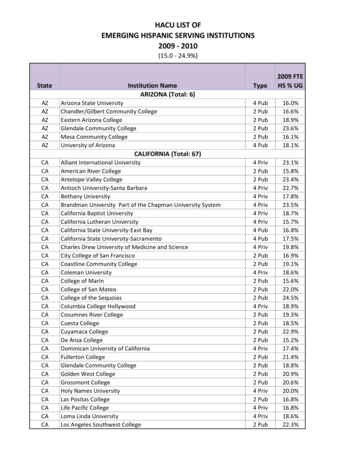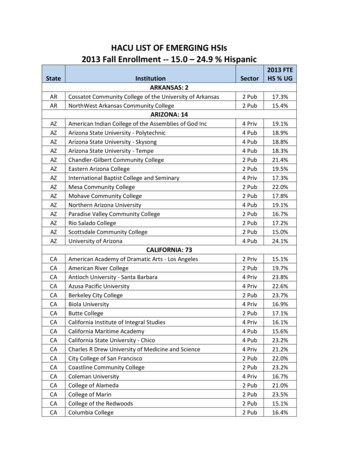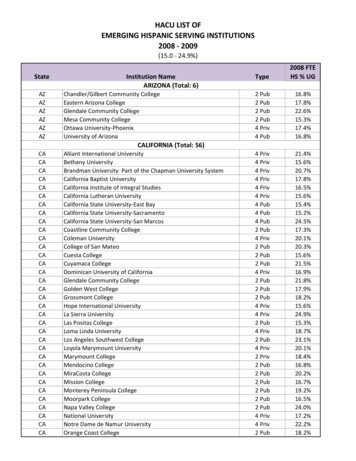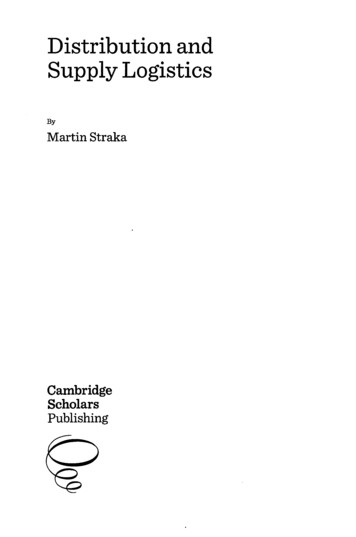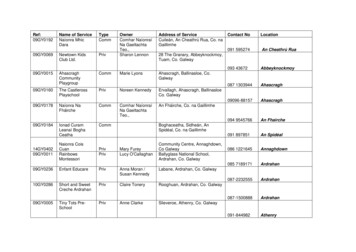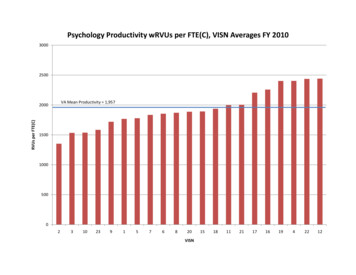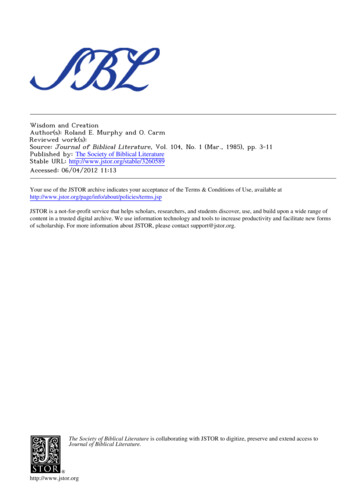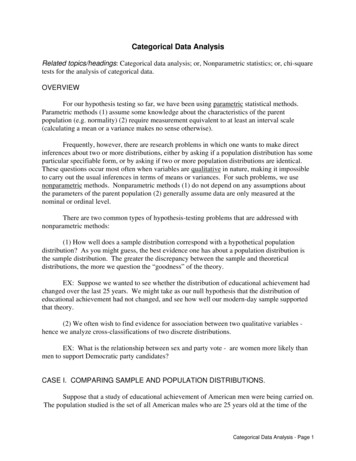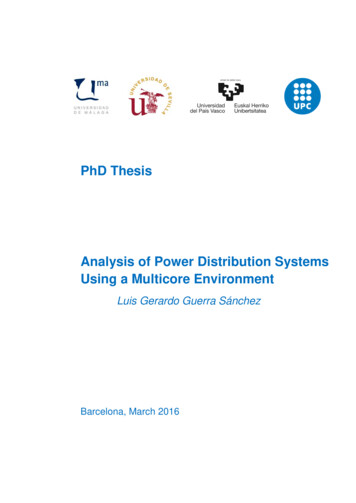
Transcription
Privatization and Distribution of ArraysA Preliminary ProposalPeng TuAbstractIn today's high performance NUMA (Non-Uniform Memory Architecture) multiprocessors with memory hierarchy or distributed memory, the partition and distribution ofdata associated with parallel computations a ect the amount of parallelism that can beexploited and the amount of data movement in the system. The objective of this researchis to study and evaluate compile time data management techniques to enhance parallelism and to improve locality of memory reference for large scienti c programs writtenin Fortran.Our rst step is to reduce the amount of shared data through privatization. Privatization is a technique that allocates a separate copy of a shared variable in the privatestorage of each processor such that each processor can access a distinct instance of thevariable. Privatization can enhance inherent parallelism of a program by eliminatingmemory-related anti- and output dependences. It can also improve the locality of references since accessing a private variable is inherently local and communication free. Wepresent our algorithm for array privatization and the result of our experiment on thee ectiveness of the algorithm.For the remaining shared data, we introduce a new concept: placement matrix, andshow its application in deriving data alignment and data decomposition to reduce communication. We also incorporate the ratio of communication to computation in ourevaluation of di erent data partitions. The work is continuing on heuristics for datadistribution and the implementation of the tools.1 IntroductionNon-Uniform Memory Architecture (NUMA) multiprocessors promise to be a cost e cientway to deliver high performance by exploring parallelism in scienti c applications. Whilethey have advantages in scalability and cost, the lack of uniform access global memorymakes it di cult to program and manage. The di erence in speed between local accessand non-local access can range from one order of magnitude for a machine with sharedmemory hierarchy such as Cedar to two orders of magnitude for a machine with distributedmemory such as CM-2. Communication cost can limit their performance. Software supportfor proper management of data distribution and load balancing become crucial for thesemachines to achieve high performance and e ciency at a reasonable programming cost.1.1 SPMD Programming ModelTwo programming models have been used for parallel multiprocessors. In the fork-joinmodel, a program is executed sequentially by one processor until it enters a parallel section.1
When entering a parallel section, the sequential thread forks into a number of parallelthreads to be executed on several processors. At the end of the parallel section, the parallelthreads join into one sequential thread with a single processor proceeds. In the SPMDmodel, all processors will execute the same program. Each processor can execute di erentpiece of work by operating on di erent piece of data. In the private section of a program,each processor computes redundantly on its private data. In the shared section of a program,each processor cooperates on a portion of parallel work on shared data. One task is createdfor each processor at the beginning and killed at the end of a program execution. Thenumber of concurrent tasks is xed for a program and the system overhead for spawningand switching is minimized. In the following SPMD program,SHARED A(100),B(100)PRIVATE XPARALLEL REGIONX .DOALL I 1, 100A(I) B(I)/XENDDOEND PARALLEL REGIONeach processor redundantly computes for private variable X and then cooperates in computing shared array A. If X is not redundantly computed, it will have to be broadcasted to allthe processors. The doall loop is shared, di erent iterations of the loop can be executed inparallel by di erent processors.The assignment of the iterations to processors is generally determined by the distributionof data involved in the computation for each iteration. For instance, if the array A and B isdistributed in such a way that A(I) and B(I) are in the same processor, the ith iterationof the loop can be scheduled to be executed on the processor where A(I) is located.Since computation and data are closely related, many compilers for distributed memorymachines use owner computes rule to determine which processor shall execute a particularpiece of a shared section[ZBG88] [CK88][RP89]. According to the data distribution speci edby user or compiler, each data element is assigned to a owner processor which is the onethat stores that data element in its local memory. The owner processor of a data itemexecutes all the instructions that modify its value. Communication command is generatedto fetch the non-local data to the owner from the computation. Parallelism is realised bypartitioning the data, hence the computation is indirectly partitioned. Data dependenceis enforced through communication of data value from the producer to consumer. SinceSPMD model can provide better e ciency, it has been supported in Cray MPP Fortran [?]and Parallel Computing Forum Fortran.1.2 Issues in Data DistributionThe task of compilers for today's high performance multiprocessors is to explore inherentparallelism in the program, and to explore the parallelism in the machines. The parallelismin the program can be explicitly speci ed by user or implicitly embedded in it data andcontrol dependence structure. The parallelism in the machine is constrained by its number2
of processors, memory organization and underlining interconnection network. A compilermaps the program parallelism onto the machine parallelism to achieve performance ande ciency. This mapping includes data partition, task partition and matching task withdata in the target machine. To obtain a good mapping, the following fundamental issuesand tradeo s must be taken into consideration.Locality and privatization. Private data are allocated in the local memory of eachprocessor, it cannot be accessed by other processors. Access to private data is inherentlylocal, privatization can improve the spatial locality of reference of a program. In the SPMDmodel, redundant execution of program can be performed on private data. This providesan opportunity for computing required data locally instead of getting the data from remoteprocessors.Load balance and communication highlights the tradeo s in the compiling process.Maximum load balance requires that computations be spread across all the processors andhence parallelism in the computations can be achieved. But then the data involved inthe computations may not be local to all the processors, communication overhead can beexpensive for bringing non-local data to the processors. Minimum communication requiresthat all the data involved in a computation to be in the same processors. Then somecomputations that could be spread into several processors may have to be executed ona single processor to preserve the data locality and hence parallelism in the program willsu er. Data replication and privatization can be used in some case to reduce communicationwhile preserving parallelism.Partition data and partition iteration space. Most compilers that generate message passing code from a shared memory program and a user speci ed data decompositiontake the data partitioning approach. Once the owner of the data is determined, messagepassing code is generated according to owner computes rule. Since the owner of the variableon the left hand side of an assignment statement is to compute its new value, messagesare generated to get values of variables owned by other processors for the computation.Communication can be reduced if the data decomposition keeps most of the data in thecomputation local. However, since the computation is indirectly partitioned, load balanceand parallelism will su er if data decomposition does not distribute the owners of the computations evenly across the processors. Partitioning of the iteration space has been usedby automatic parallelizing compilers to exploit parallelism on shared memory machines.The advantage is that it can ensure load balance and parallelism. But the communicationoverhead to bring proper data to the site of each iteration may be large since the data areindirectly decomposed.Data alignment determines which portions of two arrays shall be in the same processorfor a particular data partition. The objective of data alignment is to keep portions involvedin the same computation together so as to maximize local access and reduce communication. Most regular alignments are determined by three parameters: orientation, o set,and stride. Alignment constraints can be derived from subscript expression. Finding optimum alignment is di cult. The orientation problem has been formulated as the problem ofcomponent a nity graph and shown to be NP-complete[LC91]. As di erent computationsrequire di erent alignments, it may not be feasible to keep a xed alignment in the entireprogram. Dynamic alignment may provide a more e cient program.The communication pattern can be classi ed in various ways. We identify two classes,uniform communication and non-uniform communication. Uniform communication hap3
pens where the relationship between the sender and receiver is invariant of their locations.It is important for distributed memory multiprocessors with regular interconnection, since auniform communication is usually con ict free, i.e. each sender has a con ict free communication path to its receiver. Uniform communication usually costs less on real machines sincethe direction of data owing through the communication network is uniform and networkcongestion is less severe than non-uniform communication. Techniques like vector and blockdata transfer can be used in uniform communication to explore the regularity of machine'sinterconnection network.Pre-fetching is a way to hide the communication latency. By pre-fetching data andstoring them in local temporary locations before they are used, computation and communication can be overlapped. In the case of dynamic alignment, data can be pre-aligned, wherealignment is changed before computations are carried out on the data.We will expand on the issues in the rest of this proposal as we explain our plan for thisresearch. The rest of this proposal will be divided into two broad sections. In the rstsection, we will discuss our work on automatic array privatization [?] which can enhanceprogram's inherent parallelism and improve locality of reference on target machines byreducing the amount of shared data. In the second section, we will discuss our frameworkon automatic array distribution for exploiting parallelism and reducing communication.2 Privatization for Parallelism and Locality of ReferenceEnhancing parallelism, balancing load and reducing communication are among the majortasks of compilers for distributed memory systems. Privatization is a technique that allowseach concurrent process to allocate a variable in private storage such that each processaccesses a distinct instance of the variable. Privatization of scalars has been used for manyyears in parallelizing compilers and is well understood [BCFH89]. In this section, we willfocus on techniques for the privatization of arrays.By providing distinct instance of a variable to each processor, privatization can eliminate memory related dependences and enhance parallelism. It reduces communication sinceaccess to a private variable is local to the processor. Previous studies on the e ectivenessof automatic program parallelization show that array privatization is one of the most e ective transformations for the exploitation of parallelism [EHLP91]. Also, privatization canimprove load balancing under some translation systems targeted at distributed memorymachines. To illustrate this point, consider the loop:S0: DO I 1, NS1: DO J 1, NS2:A(J) B(I,J) 1S3:C(I,J) A(J) * D(I)S4: END DOS5: END DOHere, array A is involved in a cross iteration anti-dependence which prevents the outer loopto be executed in parallel. In a distributed memory system using the owner computes rule,load imbalance will happen due to extensive computation at the owner of A(J). If C( ; J) isnot distributed with A(J), communication will be necessary from the owner of A(J) to theowners of C( ; J).4
These problems can be relieved by array expansion [PW86] [Fea88]. For the loop above,this means expanding A into a two dimensional array as shown next:S0: DO I 1, NS1:DO J 1, NS2:A(I,J) B(I,J) 1S3:C(I,J) A(I,J) * D(I)S4:END DOS5: END DOIn this case, array expansion resolves the anti-dependence, exposes more parallelism andimproves load balance. However, expansion makes the array references more complicated.Also, distribution and alignment pattern has to be speci ed in conjunction with the expansion. Otherwise, if data are not distributed in such a way that A(I; J) is located withC(I; J), communication from the owner of A(I; J) to the owner of C(I; J) would be necessary.Array privatization together with a owner stores rule [Bal91] may result in a moree cient program. By allocating a private variable to each processor, the value of A(J) iscomputed locally, load is evenly distributed. Communication happens only for storing A(J)to its owner.S0: DO I 1, NS1:DO J 1, NS2:PRIVATE XS3:X B(I,J) 1S4:C(I,J) X * D(I)S5:IF (I.EQ.N) A(J) XS6:END DOS7: END DOIt can be completely eliminated if the compiler supports dynamic data redistribution orif the compiler determines statically that A(J) should be distributed with C(N; J). Thedynamic nature of privatization also makes it easier to adapt the program to di erentphysical machines.The bene t of array privatization is similar to that of scalar replication in distributedmemory systems [GB92][HKT91]. Instead of statically partitioning and distributing all thedata, the compiler can dynamically allocate those private data to generate more e cientcodes. In the rest of this section, we rst give some de nitions and an algorithm foridentifying privatizable arrays within loops and go through an example. Then we explainour method to evaluate the e ectiveness of its use on enhancing parallelism and give somepreliminary performance results.2.1 Array PrivatizationFor an array A to be private to a loop L, A must satisfy two conditions: (1) the array A mustbe written by some statements in L, otherwise there will be no bene t of making A privateto L; (2) if there is a use of an element of A in any iteration, that element must be writtenin the same iteration before the use. The rst condition prevents unnecessary privatization,and the second condition ensures that every use of A refers to values computed in the sameiteration.5
Note that it is possible to privatize a subsection of an array. Privatizable scalars arespecial cases where the array contains only one element. The de nition can also be generalized from iterations of a loop to threads of a program section. An array is privatizable to aprogram section when every use of the array in the section is rst written by a statement inthe same thread. Later, when we talk about interprocedure analysis, we will use subroutineinvocations as threads and nd privatizable arrays for subroutines.The problem of identifying privatizable arrays is therefore to determine for each use ofan array in a loop if there are de nitions of the array in the same iteration which must reachthe use, and no other de nitions of the array outside the iteration can reach the use. Thisproblem can be formalized in a data ow framework as discussed next.Consider a control ow graph for a loop body, which consists of basic blocks and controlow in one iteration. For each basic block S, we compute a set of must-de ne (subscripted)variables, DEF(S), and a set of possibly exposed-use variables, USE(S). By exposed, we meanthat the variable used is not de ned by any preceding statement in S and hence it is exposedto de nitions outside of S. De ne IN(S) as the set of variables that are always de ned uponentering S, and Pred(S) as the set of immediate predecessors of S in the control ow graphof the loop body. IN(S) can be computed using the following equationIN(S) \t2Pred(S)(IN(t) [ DEF(t))The evaluation of the data ow equations listed above starts at the innermost loop. Ittraverses the loop nests following the loop nest tree in post order. Intuitively, the algorithm determines privatizable arrays for the inner loop rst and propagate the de ne-useinformation of the inner loop to the outer loop.For each loop L, all the IN sets are initially set to be empty sets (fg). Data owinformation is computed for each statement and propagated through the subgraph. It isthen summarized for one iteration of L.Summary information for one iteration of L is obtained as follows. DEF(L), the set ofmust-de ned variables for one iteration of L, is the set of must-de ned variables upon exitingthe iteration, i.e. DEF(L) \(IN(t) [ DEF(t)) : t 2 exits(L). USE(L), the possibly exposeduse variables are the variables which are used in some statements of L, but do not havea reaching must-de ned in the same iteration, i.e. USE(L) [(USE(t) ; IN(t)) : t 2 L.The privatizable variables are the variables which are de ned and not exposed to de nitionsoutside the loop iteration, i.e. PRI(L) DEF(L) ; USE(L).The summarized DEF(L), USE(L) and PRI(L) are then aggregated across the iterationspace of L. The aggregation process computes the region spanned by each array referencein USE(L), DEF(L) and PRI(L) across the iteration space. Since the aggregated data containall the information for the analysis of outer loop, the inner loop L is collapsed into one singlenode in the analysis of outer loop. The algorithm is shown below.Algorithm Privatizeprivatize : func(body; L)Input: body for loop LOutput: DEF(L); USE(L); PRI(L)Phase 1: Collect local informationforeach S 2 body doif S is a DO loop then6
! S is an inner loop, visit S rst[DEF(S); USE(S)] : privatize(body(S); S)collapse all nodes in body(S) into Selsecalculate local DEF(S); USE(S)endifendforPhase 2: Propagate ow informationforall S 2 body initialize IN(S) : fgforeach S 2 body in topological order doIN(S) : \t Pred(S)(IN(t) [ DEF(t))until x-pointPhase 3: Compute PRI(L); DEF(L); USE(L) as a function of the loop indexDEF(L) : \t exits(body)(IN(t) [ DEF(t))USE(L) : [t body(USE(t) ; IN(t))PRI(L) : DEF(L) ; USE(L)Phase 4: Return aggregated DEF(L) and USE(L)aggregate PRI(L),DEF(L) and USE(L) in Lannotate L with PRI(L), return [DEF(L); USE(L)]222Using the inner loop in our example at the beginning of this section, we illustrate the stepstaken by our algorithm in determining privatizable arrays. In phase 1{2, we compute localUSE and DEF for each statement, propagate the information in topological order through theloop body and compute the IN sets. The result for the original ,J}In phase 3, we summarize the information for one iteration of L:DEF(L) IN(S4) {A(J),C(I,J),J}USE(L) (USE(S1)-IN(S1)) (USE(S2)-IN(S2)) (USE(S3)-IN(S3)) (USE(S4)-IN(S4)) {B(I,J),D(I),I,N}PRI(L) DEF(L) - USE(L) {A(J),C(I,J),J}In phase 4, we aggregate the summary information across the iteration space to get corresponding information for all the iterations of loop L:PRI(L) {(A(J),J 1,N),(C(I,J),J 1,N),J}DEF(L) {(A(J),J 1,N),(C(I,J),J 1,N),J}USE(L) {(B(I,J),J 1,N),D(I),I}PRI(L) and DEF(L) can be1; N) 2 PRI(L) and there issimply expanded across the iteration space. Since (A(J); J no free variable in (A(J); J 1; N), A(1 : N) is privatizable to L.7
USE(L)can also be expanded in the same way but the result may not be precise since oneiteration's use may only be exposed to the de nitions in some previous iterations of thesame loop. This kind of use is not truly exposed to the outside of the loop body and shallbe excluded from the aggregated USE set. For instance, inDO I 2, NS1: A(I) A(I-1) B(J)END DOthe information for one iteration is USE(L) fA(I ; 1); B(J); Jg, and DEF(L) fA(I)g, theregion aggregately de ned in all iterations prior to the ith iteration is A(2 : I ; 1), A(I ; 1)is exposed to de nitions outside the loop only in the rst iteration, i.e. USE(L) fA(1)g.Now, we can collapse the loop body into one node L with the aggregated DEF(L) andUSE(L) as its local information and run the same procedure for the outer loop.Live analysis is needed to determined if a privatizable variable is live on exiting the loop.If it is live on exit, last value assignment will be necessary to preserve the semantics of theoriginal program. We have developed a method to statically determine which iteration willassign the last value. Last value assignment can also be resolved at run time using iterationnumber tag.The algorithm can generalized to deal with subroutine calls. All what is needed is tosubstitute subroutine body for loop iteration in the algorithm, summary information iscomputed for each subroutine. An analysis of the subroutines in their inverse calling ordertogether with mappings from formal parameters to actual parameters and global variablesgive us the abilities to determine privatizable variables in loops with subroutine calls. Wehave implemented the generalized algorithm and it is used in the next section to evaluatee ectiveness.2.2 E ectiveness EvaluationTo evaluate the e ectiveness of the algorithm, we implemented the algorithm using theDelta Program Manipulation System [Pad89]. The evaluations are made by comparing aprogram's optimal loop level parallel execution times with and without array privatization.Speedups are computed for each program with array privatization and without array privatization assuming loop level parallelism. An upper bound of the optimal loop level speedupfor a program is also computed by ignoring all the anti-dependences. In all the calculations,we use a strategy introduced by Kumar [Kum88] to measure a program's execution timeon an ideal machine where only the arithmetic operations consume time and an unlimitednumber of processors are available.A program is instrumented such that run-time reference information about memory locations is used to detect the ow dependences and anti-dependences [Che89][PP92]. Theoptimal parallel execution time ignoring anti-dependences is obtained by calculating themaximum length over all ow dependence chains. The parallel execution time of theprogram without privatization is the maximum length over all ow dependence or antidependence chains. Privatization will break some of the anti-dependences, hence a chaininvolving anti-dependences may be cut into several shorter chains by privatization. Theparallel execution time of the program with privatization is the maximum length over allow or anti-dependence chains after the privatization breaks some of those chains.8
The instrumentation is implemented by introducing a read shadow variable and a writeshadow variable for each program variable. A read shadow variable records the latest timewhen a variable was read, and a write shadow records the earliest time when a variable wasassigned. The earliest time a variable can be assigned is when the lastest read for the variablewas nished, all the operands used in calculating new value for the variable were writtenand the computation for the new value was nished. To measure loop level parallelism,control dependences are added from every statement instance to its successors in the sameiteration, which ensures the sequential execution of statements in the same iteration. Aread shadow for a private variable is created locally for a loop iteration, di erent iterationshave di erent shadows for a private variable, hence the anti-dependences are broken acrossiterations. Optimal execution time is computed by ignoring all the read shadow variables.Six programs in the Perfect Benchmark Club [CKPK90] were instrumented. The looplevel speedup results are reported in the table below. The results without privatizationshow that memory related dependences can severely limit parallelism in programs. Afterarray privatization, we get speedups within for ve cases within a factor of two of theoptimal speedups. The di erences between optimal speedups and privatization speedupsare due to several factors: (1) Our algorithm is e ective when subscript expressions arefunctions of loop indices. Its e ectiveness is limited by the system's ability to forwardsubstitute induction variables and to propagate constants. Another di culty is when arrayreferences are used in subscript expressions. (2) Although we can handle symbolic loopboundaries, there are cases where two symbolic boundaries have the same value but wecannot establish that they are equivalent. (3) There are also cases where the privatizabilityof arrays depends on some conditions. We are currently conducting experiments on otherprograms in the Perfect Club. It is our intention that by testing more applications, we canidentify di culties and new techniques to improve the performance of our algorithm.WithWithoutProgram Optimum Privatization .61.6Table 1. Loop Level Speedup Ratios3 Data DistributionData distribution determines the layout of data in the system to minimize communicationand to maximize parallelism. Data distribution can be divided into two phases: dataalignment and data decomposition. Data alignment determines the relative position ofdi erent arrays such that array elements involved in the same computation are often in thesame memory module to increase local access. Data decomposition determines the partitionof arrays to explore parallelism and limit communication.There are two classes of data object in the SPMD programming model: private variablesand shared variables. Private variables are replicated on all the processors. Each processor9
allocates private variables in its local storage. Private variables with the same name mayhave di erent values on di erent processors. Shared variables are accessible to all theprocessors. Shared arrays can be distributed across the processors. Only one copy of eacharray element exists in the whole system. Arrays can be distributed dimensionally whereeach dimension being distributed independent of all other dimensions. A dimension is calledfully parallel if di erent column in that dimension is allocated on a di erent processor. Itis called sequential if all the columns in that dimension is allocated on a single processor.When there is parallel computation on a dimension of a shared array, the dimensiongenerally shall be distributed in parallel such that di erent processors can work on different columns allocated in their local memory in parallel. When there is only sequentialcomputation on a dimension of a shared array, the dimension should be allocated on asingle processor such that communication and synchronization can be minimized. Hence,the distribution of the shared arrays and the sharing of the parallel work have to be treatedintegrately to achieve parallelism and locality of reference.In this section, we will present some techniques that will be useful in this work. Noalgorithm exists yet. Since the general problem is NP complete, our objective is to ndsome good heuristics to exploit parallelism and reduce communication. We rst discussdata alignment. We introduce a placement matrix to represent how the array is distributedin a virtual processor array and give an equation to compute the placement matrix andhence the distribution. The objective is to nd a placement such that all the elementsaccessed in an iteration of a parallel loop are located on the same virtual processor. Thenwe will discuss data decomposition when communication is necessary. The objective it tond a data decomposition which can fully use the parallelism on a target machine and theprogram while reducing the ratio of communication to computation.3.1 Data AlignmentSeveral factors determine data alignment. There are orientation, o set, and stride. Considerthe following loop:DO I 1, NDO J 1, NA(I,J) B(J,I)END DOEND DOTo have local access of both A(I; J ) and B (I; J ) for each iteration, array A and B shallbe transposed placed with each other. That is, the rst dimension of B shall be orientedwith the second dimension of A, and the second dimension of B shall be oriented with therst dimension of A. Let (Tr)(B) be a transposely placed array B, then the following loopis equivalent to the above one but has all the elements aligned.DO I 1, NDO J 1, NA(I,J) (Tr)(B)(I,J)END DOEND DO10
Note that (Tr) is a notation for the original placement of B, it is not a run time operationto transpose array B.3.1.1 Array Occurrence and Array Placement MatrixArray alignment depends on the access pattern of the arrays in the computation. Matrixrepresentation of array occurrence is a convenient way to represent the array references inthe program. For instance:(I; J ) (I; J ) 10 01!(J 1; I ) (I; J ) 01 10! (1; 0)Note that a subscript matrix consists of two part. The rst part is a matrix productre ecting that the subscript in each dimension can be a linear combination of loop indexvariables. The second part is a vector re ecting the o set along each dimension. We willuse (C; S ) to denote an array occurrence with combination matrix as C and shifting vectoras S .For an n-dimensional loop (I1 ; I2; : : :; In ), one can de ne a one-to-one mapping fromthe iteration space to an n-dimensional virtual processor network with exactly one iterationper processor. Array placement in the virtual processor network can also be represented ina matrix form. Placement matrix specifys how an array is placed in a multi-dimensionalvirtual processor network. For instance, we can place array B transposed in the virtualprocessor network using the placement matrix0 11 0OB !To calcu
maps the program parallelism on to the mac hine parallelism to ac hiev e p erformance and e ciency. This mapping includes data partition, task partition and matc hing task with data in the target mac hine. T o obtain a go o d mapping, the follo wing fundamen tal issues and tradeo s m ust b e tak en in to consideration. Lo calit y and priv .
